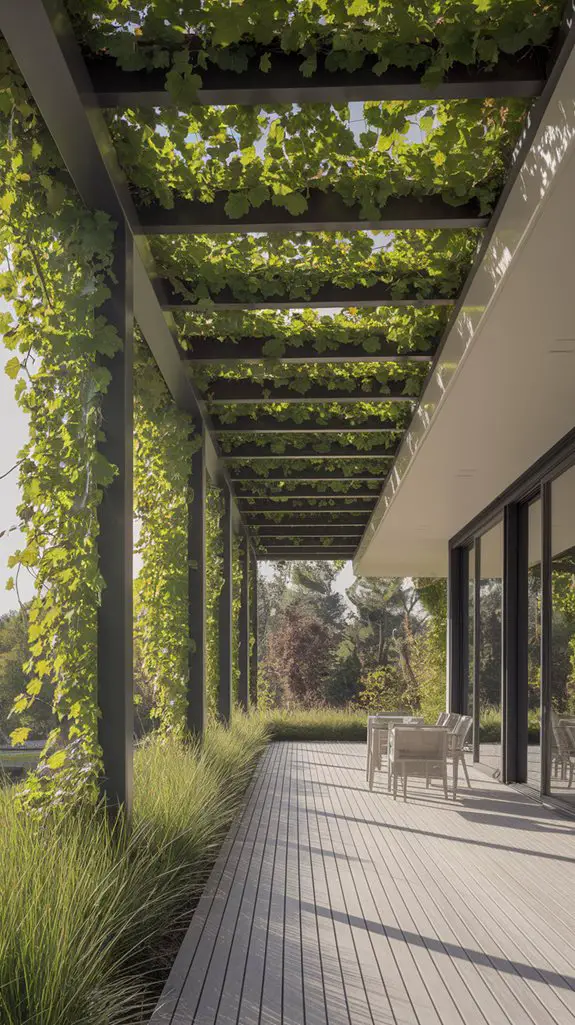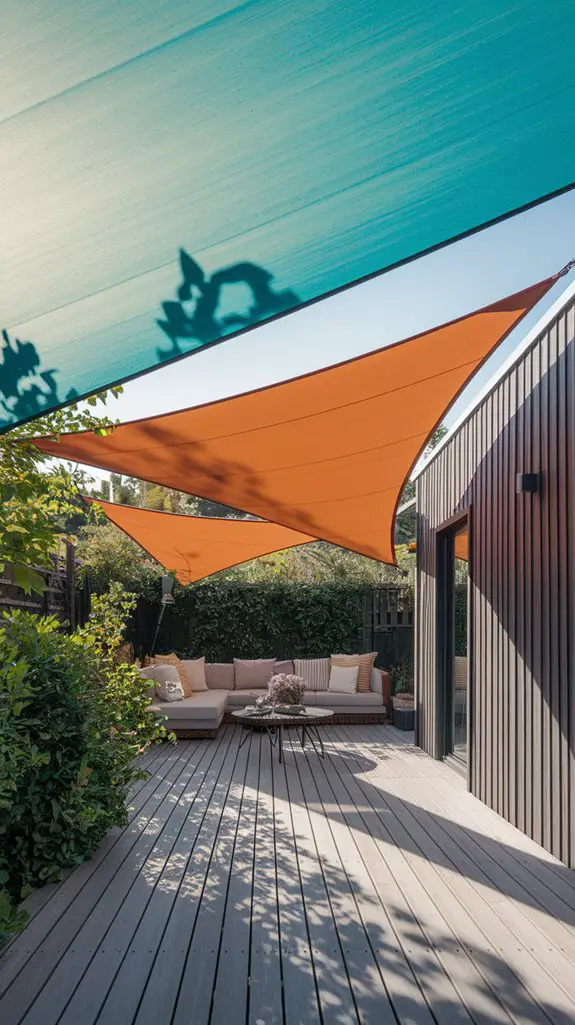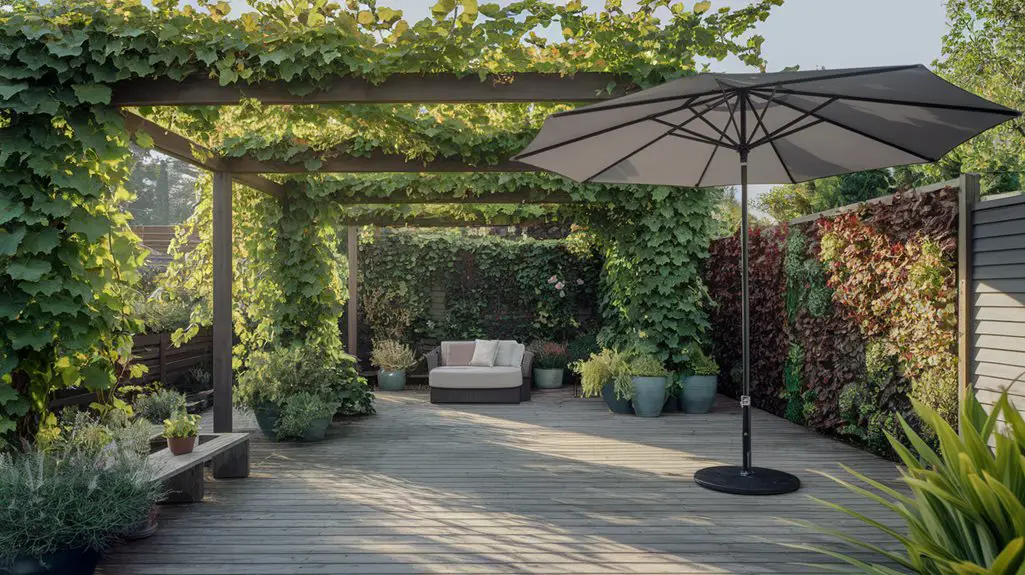If you’re looking to cool your outdoor space while minimizing environmental impact, sustainable patio shade options offer elegant solutions. You’ll find a spectrum of choices from natural bamboo structures to innovative solar-integrated canopies that generate power while they protect. Unlike conventional options, eco-friendly shade systems reduce carbon footprints, conserve resources, and often enhance your property’s biodiversity. The ideal sustainable shade doesn’t just block sun—it works harmoniously with the surrounding ecosystem.
Natural Bamboo Pergolas and Canopies
While traditional pergolas often require harvesting slow-growing hardwoods, bamboo pergolas offer a distinctly sustainable alternative that’s both renewable and visually striking. Bamboo grows at an astonishing rate of up to 91 cm daily, reaching harvest maturity in just 3-5 years compared to hardwoods’ decades-long growth cycle. You’ll find that properly treated bamboo delivers impressive structural integrity with a tensile strength rivaling steel. Select bamboo species like Moso or Guadua for load-bearing applications. For peak durability, verify your bamboo is properly treated with boric acid solutions to resist insects and decay. Consider implementing a pitched design to enhance rainwater runoff, and incorporate UV-resistant lashing techniques when joining poles. This approach maximizes your structure’s lifespan while maintaining its carbon-negative environmental profile. Additionally, bamboo is one of the most sustainable building materials available, making it an excellent choice for eco-conscious projects.
Living Green Roof Shade Structures

Living green roof shade structures represent perhaps the most ecologically integrated approach to patio shading, as they transform what would be merely structural elements into dynamic, functioning ecosystems.
You’ll need a reinforced framework to support the weight of soil, plants, and moisture. Select shallow-rooted sedums, succulents, and native grasses that require minimal irrigation once established. These plants create natural insulation, reducing ambient temperatures beneath your patio by 8-12°F compared to conventional roofing.
The benefits extend beyond shade—you’ll capture rainwater, filter air pollutants, and create microhabitats for beneficial insects. Additionally, choosing eco-friendly options for your garden paths can enhance the overall sustainability of your outdoor space.
Consider incorporating a simple irrigation system with moisture sensors to maintain plant health during dry periods. For maximum sustainability, collect roof runoff in rain barrels to supply your green roof’s water needs during drought conditions.
Recycled Fabric Shade Sails and Awnings

Recycled fabric shade sails and awnings offer a lightweight alternative to green roofs when structural reinforcement isn’t practical for your outdoor space.
These versatile installations use post-consumer materials such as recycled polyester from plastic bottles or reclaimed industrial textiles to create UV-resistant canopies that reduce your carbon footprint.
- PET fabric options – Made from recycled plastic bottles, offering 85-95% UV protection while diverting waste from landfills
- Reclaimed canvas – Repurposed materials with natural aesthetics and biodegradable properties at end-of-life
- Modular designs – Configurable geometries allow for seasonal adjustments and ideal sun tracking
- Low-impact installations – Tension-based systems require minimal hardware and can be disassembled without environmental damage
You’ll benefit from reduced cooling costs while making an environmentally responsible choice that doesn’t compromise on style or functionality. Additionally, choosing eco-friendly paint options can further enhance the sustainability of your outdoor furniture.
Solar Panel Integrated Patio Covers
Solar panel integrated patio covers represent the ultimate fusion of form and function in sustainable outdoor design.
These structures capture solar energy while providing necessary shade, effectively transforming your outdoor space into a micro power plant.
You’ll benefit from reduced energy bills as these systems generate electricity for your home while blocking 100% of UV rays.
Modern designs feature tempered glass panels that allow filtered light through while maintaining structural integrity in harsh weather.
Installation requires professional assessment to optimize panel angle and positioning for maximum energy production.
Most systems connect to your home’s electrical grid through net metering, allowing you to sell excess power back to utilities.
The initial investment typically ranges from $10,000-$25,000, but federal tax credits can offset 30% of costs, with complete ROI possible within 7-10 years.
Drought-Resistant Vine Trellises for Natural Shade
Nature’s most elegant shade solution comes in the form of drought-resistant vine trellises that transform outdoor spaces while minimizing water consumption.
You’ll create a living canopy that evolves with the seasons while reducing your environmental footprint.
- Choose climate-appropriate species like bougainvillea, trumpet vine, or wisteria that thrive with minimal irrigation after establishment.
- Install appropriate structural supports—galvanized steel frames offer durability while reclaimed wood provides rustic aesthetic with carbon sequestration benefits.
- Implement precision drip irrigation systems that deliver water directly to root zones, reducing consumption by up to 60% compared to conventional methods.
- Position trellises strategically to maximize summer shade while allowing winter sunlight penetration, optimizing your home’s passive thermal regulation.
This green infrastructure approach delivers shade plus habitat creation, improved air quality, and enhanced biophilic connection to your outdoor environment. Additionally, integrating eco-friendly options in your backyard design can further promote sustainability and enhance the overall aesthetic.
Reclaimed Wood Pergolas and Arbors
While vine canopies provide living shade solutions, reclaimed wood pergolas and arbors offer architectural permanence with impressive sustainability credentials.
You’ll find these structures divert timber from landfills while creating elegant overhead frameworks for your outdoor space.
Source your materials from dismantled barns, warehouses, or salvage yards where weathered cedar, redwood, and oak await new purpose. The natural patina of aged wood brings character impossible to replicate with new lumber.
For joinery, choose rust-resistant hardware made from recycled metals.
Design your pergola with removable canvas panels or retractable shade cloths to maximize seasonal flexibility. Consider integrating solar panels on south-facing sections to generate power while creating shade.
When properly sealed with non-toxic finishes, your reclaimed wood structure will resist decay for decades, extending its environmental benefits well into the future. Additionally, using eco-friendly fencing materials can further enhance the sustainability of your outdoor living space.
Native Plant Windbreaks and Privacy Screens
Beyond the architectural elegance of pergolas, strategic plantings of native species can transform your outdoor space into a protected sanctuary where environmental benefits multiply. Native plants require less water, fertilizer, and maintenance while providing essential habitat for local wildlife and pollinators.
- Layered plantings – Combine tall grasses, shrubs, and small trees to create multi-level wind diffusion that prevents harsh gusts while allowing gentle breezes.
- Strategic positioning – Place dense evergreens on prevailing wind sides and deciduous species where you’ll want winter sun.
- Vertical trellising – Train vining natives like Virginia creeper or trumpet honeysuckle on recycled wire systems.
- Seasonal diversity – Select species with staggered blooming periods to guarantee year-round visual interest and continuous ecological benefits. Additionally, incorporating native plants into your garden can significantly enhance biodiversity by attracting various species of birds and insects.
Rain-Harvesting Shade Systems
Rain collection systems that simultaneously provide shade represent the ultimate fusion of form and function for today’s eco-conscious homeowner. These innovative structures capture rainfall while protecting your outdoor living space from harsh sunlight. Additionally, incorporating sustainable rainwater harvesting techniques can enhance the efficiency of these systems.
| System Type | Water Capacity | Installation Complexity |
|---|---|---|
| Canvas-Top Collectors | 10-30 gallons | Low |
| Pergola Integrated | 50-200 gallons | Medium |
| Retractable Mesh | 15-40 gallons | Medium |
| Solar-Powered Automated | 100-500 gallons | High |
| Green Roof Hybrid | 200-1000+ gallons | Very High |
You’ll maximize your investment by selecting a system that matches your regional rainfall patterns and water needs. Most configurations direct water through gutters into storage tanks, where it’s filtered for irrigation use. The translucent or semi-transparent designs diffuse sunlight rather than block it completely, creating pleasant dappled light patterns across your patio while conserving precious water resources.
Hemp and Organic Cotton Shade Solutions
For environmentally conscious outdoor spaces, natural fiber shade solutions made from hemp and organic cotton have emerged as sustainable alternatives to synthetic materials.
These biodegradable fabrics offer durability while reducing your environmental footprint. Hemp resists UV damage and mildew, while organic cotton provides breathable comfort without pesticide residues.
- Water conservation – Hemp requires 50% less water than conventional cotton and minimal pesticides
- Carbon sequestration – Hemp plants absorb 1.63 tons of CO₂ per ton grown
- Biodegradability – Natural fibers decompose in 1-5 years versus decades for synthetics
- Thermal efficiency – Hemp-cotton blends offer 35% better heat regulation than polyester awnings
You’ll find these materials in sail shades, pergola covers, and drop cloths, often treated with non-toxic waterproofing solutions to extend their functional lifespan in outdoor settings. Additionally, sustainable landscaping practices can further enhance the eco-friendliness of your garden.
Energy-Efficient Retractable Canopy Systems
Energy-efficient retractable canopy systems represent the next evolution in sustainable patio shade technology.
These dynamic installations combine automation with renewable energy to create adaptable outdoor environments that respond to changing weather conditions.
You’ll find most premium systems now incorporate solar-powered motors that eliminate the need for grid electricity, while integrated light sensors automatically adjust the canopy’s position to optimize shade coverage.
This intelligent responsiveness reduces your cooling costs by up to 25% during summer months.
Look for models featuring recycled polyester fabric with UV-resistant coatings that extend the material’s lifespan to 10+ years.
The aluminum tracking systems now weigh 30% less than previous generations, requiring fewer resources to manufacture while maintaining structural integrity even in high winds.
Moreover, these systems enhance your outdoor space by providing patio sun protection, ensuring you can enjoy your patio comfortably in various weather conditions.
Conclusion
Sustainable patio shade solutions aren’t just eco-friendly—they’re smart design choices for your outdoor space. You’ll reduce your environmental footprint while creating comfortable, beautiful areas for relaxation. Consider the case of the Hillside Eco-Home in Portland, where a rain-harvesting pergola system collects 600 gallons annually while supporting native wisteria, demonstrating how thoughtful shade design can simultaneously address multiple sustainability goals with precision and style.




